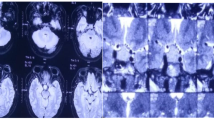Abstract
Pyoderma gangrenosum is a rare chronic and recurrent skin disease characterized by progressing lesions from papulopustules to large necrotic sterile ulcers. Its definite etiology remains unknown. In a 40-year-old woman with typical pyoderma gangrenosum an intrasellar mass with suprasellar extension was diagnosed and removed by transsphenoidal surgery. Histo-pathological features of the lesion were those of a nonspecific granulomatous hypophysitis. Five months postoperatively the patient experienced visual defects and hypopituitarism demonstrated by endocrine evaluation. Computerized tomography showed the recurrence of the intrasellar expanding mass. Extensive and repeated evaluation failed to find any evidence of sarcoidosis, tuberculosis or histiocytosis. Corticosteroid therapy was preferred to surgery and 80 mg daily prednisone produced a dramatic shrinkage of the pituitary pseudotumor. Long-term follow-up studies did not disclose any recurrence of the pituitary granulomatous process nor objective evidence of underlying disease even after steroid dosage has been tapered. The hypothesis of a pituitary localization of pyoderma gangrenosum is suggested by the similarity between the histopathologic findings of the two conditions and the excellent response to steroid therapy.
Similar content being viewed by others
References
Powell F.C., Schroeter A.L., Su W.P.D., Perry H.O. Pyoderma gangrenosum: a review of 86 patients. Q.J. Med. 217: 173, 1985.
Newell L.M., Malkinson F.D. Commentary: Pyoderma gangrenosum. Arch. Dermatol. 118: 769, 1982.
Powell F.C., Schroeter A.L., Su W.P.D., Perry H.O. Pyoderma gangrenosum and monoclonal gammopathy. Arch. Dermatol. 119: 468, 1983.
Asa S.L., Bilbao J.M., Kovacs K., Josse R.G., Kreines K. Lymphocytic hypophysitis of pregnancy resulting in hypopituitarism: a distinct clinicopathologic entity. Ann. Intern. Med. 95: 166, 1981.
Mayfield R.K., Levine J.H., Gordon L., Powers J., Galbraith R.M., Rawe SE. Lymphoid adenohypophysitis presenting as a pituitary tumor. Am. J. Med. 69: 619, 1980.
Vesely D.L., Maldonodo A., Levey G. Partial hypopituitarism and possible involvement in sarcoidosis. Report of a case and review of the litterature. Am. J. Med. 62: 425, 1977.
Rickards A.G., Harvey P.W. “Giant cell granuloma” and the other pituitary granulomata. Q.J. Med. 23: 425, 1954.
Hoick S., Laursen H. Prolactinoma coexistent with granulomatous hypophysitis. Acta Neuropathol. (Berl) 61: 253, 1983.
Del Pozo J.M., Roda J.E., Montoya J.G., Iglesias J.R., Hurtado A. Intrasellar granuloma: case report. J. Neurosurg. 53: 717, 1980.
Case records of the Massachusetts General Hospital (case 5-1985). N.Engl. J. Med. 312: 297, 1985.
Hassoun P., Anayssi E., Salti I. A case of granulomatous hypophysitis with hypopituitarism and minimal pituitary enlargement. J. Neurol. Neurosurg. Psychiatry 48: 949, 1985.
Albini C.H., Mac Gillivray M.H., Fisher J.E., Voorhess M.L., Klein D.M. Triad of hypopituitarism, granulomatous hypophysitis and ruptured Rathke’s cleft cyst. Neurosurgery 22: 133, 1988.
Siqueira E., Tsung J.S., Zuheir Al-Kawi M., Woodhouse N. Case report: idiopathic giant cell granuloma of the hypophysis: an unusual cause of panhypopituitarism. Surg. Neurol. 32: 68, 1989.
Scanarini M., D’Avella D., Rotilio A., Kitromilis N., Mingrino S. Giant-cell granulomatous hypophysitis: a distinct clinicopathological entity. J. Neurosurg. 77: 681, 1989.
Holt P.J.A., Davies M.G., Saunders K.C., Nuki G. Pyoderma gangrenosum. Clinical and laboratory findings in 15 patients with special reference to polyar thritis. Medicine 59: 114, 1980.
Author information
Authors and Affiliations
Rights and permissions
About this article
Cite this article
Chanson, P., Timsit, J., Kujas, M. et al. Pituitary granuloma and pyoderma gangrenosum. J Endocrinol Invest 13, 677–681 (1990). https://doi.org/10.1007/BF03349595
Received:
Accepted:
Published:
Issue Date:
DOI: https://doi.org/10.1007/BF03349595




